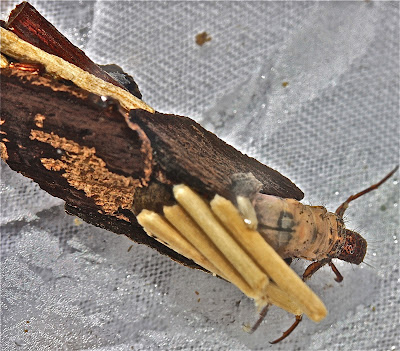Lots of exciting finds this morning at the Rapidan River, though photography was a struggle with the sun going in and out of the clouds. Most exciting for me -- a new species of Isoperla Perlodid stonefly. I think it's I. transmarina, but I need to do further research before I decide that for sure. I'll see if I can get Steven Beaty to have a look at my photos.
There are three features that -- for me -- point in the direction of I. transmarina. 1) The "width of [the] triangular pale spot in [the] ocellar triangle [is] about one half the distance between the lateral ocelli..." 2) The "pale area anterior to [the] median ocellus [is] enclosed...or not enclosed and open in front..." And 3) The "longitudinal abdominal stripes [are] subequal in width, with narrow pale borders." (all quoted from Steven Beaty's "The Plecoptera of North Carolina," p. 24.) Those features are noted in the following photo.
The pale borders on the abdominal stripes are very clear. More to come once I've more thoroughly studied this issue. Now on to some other neat finds. (I'd say the most common insect I saw today was still the spiny crawler mayfly -- E. dorothea -- with brushlegged mayflies coming in a close second.)
_____________
1. Another Northern case-maker caddis -- genus Pycnopsyche -- who had made yet another spectacular case.
This is one of the things I was hoping to find today, and I took a lot of pictures.
I love finding these cases. But you have to be on your toes to spot them since they are built to blend in with their backgrounds.
2. Perlodid stonefly, genus Remenus. I saw quite a few, and they're much more mature than those we're finding in Sugar Hollow (note how the wing pads are flaring out from the body).
3. A mature Peltoperlid stonefly, genus Tallaperla: I think a lot of them have already hatched.
4. A mature Isoperla namata Perlodid stonefly, the only I. namata I saw.
5. And here is one of the many brushlegged mayflies I saw, and I saw a lot of BIG brushlegged nymphs that look like they're ready to hatch. (Note the long wing pads on this one.)
And here's a great close-up of the "brushy" front legs.
______________
I also saw a lot of I. holochlora Perlodids and one, lonely, Acentrella turbida small minnow mayfly. Now back to the work of sorting and editing photos.















No comments:
Post a Comment